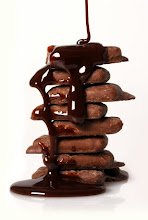Street Trends - Part I
The Zoot Suit is a suit with high-waisted, wide-legged, tight-cuffed, pegged pants and a long coat with wide lapes and wide padded shoulders. It was popularized by African-Americans, Mexican-American, Puerto Ricans, Italian American, and Filipino Americans in the late 1930 and 1940s. Teddy Boys stem from a British subculture in which young men wear clothes inspired by the Edwardian period. The style was reintroduced after World War II and the name is the result of newspaper headline which shortened Edward to Teddy. Teddy Boy clothing consists of long drape jackets with velvet collars and flap pockets; high-waist pants paired with brightly colored socks; chunky large crepe soled shoes, and high-neck , loose collars, on white shirts.
Teddy Boys stem from a British subculture in which young men wear clothes inspired by the Edwardian period. The style was reintroduced after World War II and the name is the result of newspaper headline which shortened Edward to Teddy. Teddy Boy clothing consists of long drape jackets with velvet collars and flap pockets; high-waist pants paired with brightly colored socks; chunky large crepe soled shoes, and high-neck , loose collars, on white shirts. Beatnik style stems from a media stereotype from the 1950s an early 1960s. The cartoonish and sometimes violent culture contains aspects of the Beat Generation, a literary movement of writers who reached success during the 1950s. The fashion aspects include black turtlenecks, bongos, berets, and dark glasses.
Beatnik style stems from a media stereotype from the 1950s an early 1960s. The cartoonish and sometimes violent culture contains aspects of the Beat Generation, a literary movement of writers who reached success during the 1950s. The fashion aspects include black turtlenecks, bongos, berets, and dark glasses. Mods (originally Modernist) is a subculture hat originated in London, England and was popular in the late 1950s to mid 1960s. It includes elements fashion, usually tailor made suits; pop music, African American soul, Jamaican, British beat music, and R&B. The mass media dubbed the term mod due to the subcultures appreciation for anything modern, fashionable, or popular.
Mods (originally Modernist) is a subculture hat originated in London, England and was popular in the late 1950s to mid 1960s. It includes elements fashion, usually tailor made suits; pop music, African American soul, Jamaican, British beat music, and R&B. The mass media dubbed the term mod due to the subcultures appreciation for anything modern, fashionable, or popular.Mod fashion adopted Italian and French styles and included smooth sophisticated looks, tailor-made garments, narrow lapels, mohair clothes, thin ties, button-down collar shirts, wool or cashmere sweaters, loafers, and bowling shoes.
Short haircuts, men’s trousers or shirts, flat shoes, and little makeup were mod fashion for women.

Hippie culture began as a youth movement during the early 1960s and spread around the world. The word is derived from hipster which was initially used to describe the beatniks who moved to the Haight-Ashbury district of San Francisco. The culture embraced revolution, sexual freedom, psychedelic theories, and drug use. Hippie fashion consisted of a careless look, if you will, long hair, natural fabrics, huge frocks, suede, leather, fringes, and the like.

Disco fashion is all about a fabulous celebration of glamour. It’s fashions are bold, attention-getting, and often misunderstood. The disco culture started in Philadelphia in the late 1960s and early 1970s. The fashions included sequin gowns, large heeled shoes (also known as platforms), long eyelashes, bell-bottoms, wide collars, and large hats
Punk fashion is the brainchild of Vivienne Westwood. It is the distinct social attire of other social movements including glam rock, greasers, mods, skinheads, and rude boys. Punk fashion is all about making a statement. Elements of punk fashion include fishnet stockings, frayed jeans, muscle tees, brightly colored clothes, leggings, leather pants, spiked jewelry, and body piercings.

Hip-Hop fashion originated from African-American, Caribbean-American, and Latino youth in New York in the early 1980s. Hip-Hop icons often wore name brand track suits, eyeglasses known as Cazals or Gazelles, big jewelry, sheepskin, and leather bomber jackets during their performances. Since then the fashion has grown to include red, black, and green clothing, African chains, dreadlocks, baseball caps, over-sized jewelry also known as “bling”, white tee shirts, jeans, and athletic gear.


Teddy Boys on the Runway


Beatnik on the Runway


Mods on the Runway


Hippie Trends on the Runway


Disco Trends on the Runway

Punk Fashion on the Runway


Hip-Hop on the Runway


Street Trends - Part 3
Trend 1: The Skinny Jean & Pant
Celebs in skinny jeans.
Celebs in skinny jeans.






























